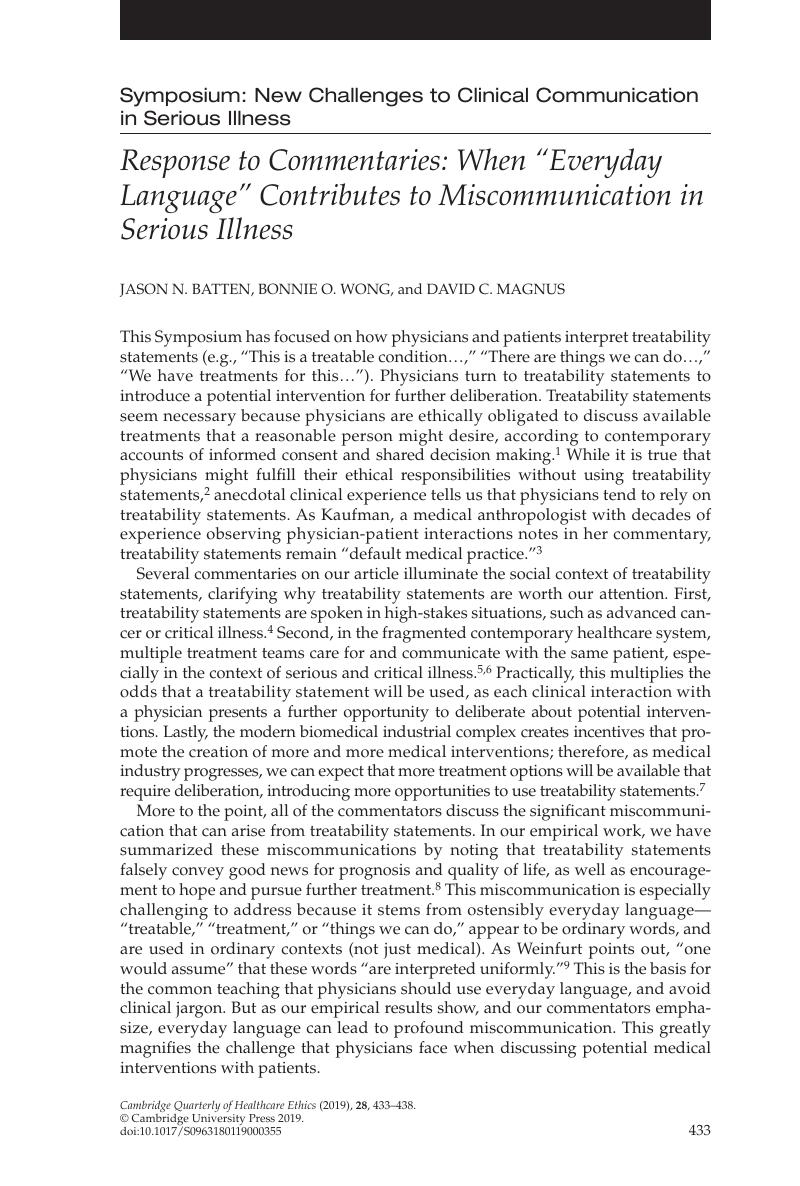Published online by Cambridge University Press: 12 July 2019

1. Kon, AA, Davidson, JE, Morrison, W, Danis, M, and White, DB. Shared decision making in intensive care units: an American College of Critical Care Medicine and American Thoracic Society policy statement. Critical Care Medicine 2016;44(1):188–201.CrossRefGoogle ScholarPubMed
2. Lynn, J. Commentary: “When I Use a Word,” with respect to Lewis Carroll. Cambridge Quarterly of Healthcare Ethics 2019;28(3):410–2.CrossRefGoogle Scholar
3. Kaufman, SR. Commentary: Whither physician talk and medicine’s tools? Cambridge Quarterly of Healthcare Ethics 2019;28(3):405–9.CrossRefGoogle Scholar
4. See note 3, Kaufman 2019.
5. See note 2, Lynn 2019.
6. See note 3, Kaufman 2019.
7. See note 3, Kaufman 2019.
8. Batten, JN, Kruse, KE, Kraft, SA, Fishbeyn, B, Magnus, D. What does the word ‘treatable’ mean? Implications for communication and decision making in critical illness. Critical Care Medicine 2019;47(3):369–76.CrossRefGoogle ScholarPubMed
9. Weinfurt, KP. Commentary: Dangerous disconnections. Cambridge Quarterly of Healthcare Ethics 2019;28(3):413–14.CrossRefGoogle Scholar
10. See note 2, Lynn 2019.
11. Xafis, V, Wilkinson, D. Commentary: Treating ambiguity in the clinical context: Is what you hear the doctor say what the doctor means? Cambridge Quarterly of Healthcare Ethics 2019;28(3):422–32.CrossRefGoogle Scholar
12. See note 3, Kaufman 2019.
13. See note 9, Weinfurt 2019.
14. Austin, JL. How To Do Things with Words, 2nd ed. Cambridge: Harvard University Press; 1962.Google Scholar
15. Brindley, PG. Commentary: Communication: The most important “procedure” in healthcare and bioethics. Cambridge Quarterly of Healthcare Ethics 2019;28(3):415–21.CrossRefGoogle Scholar
16. See note 11, Xafis, Wilkinson 2019.
17. Maher, J, Velikova, G, Betteley, A. Incurable, but treatable: How to address challenges for an emerging group. BMJ Supportive & Palliative Care 2015;5(4):322–4.CrossRefGoogle ScholarPubMed
18. Batten, JN, Wong, BO, Hanks, WF, Magnus, D. We convey more than we (literally) say. American Journal of Bioethics 2018;18(9):1–3.CrossRefGoogle ScholarPubMed
19. See note 2, Lynn 2019.
20. See note 11, Xafis, Wilkinson 2019.
21. See note 11, Xafis, Wilkinson 2019.
22. Weeks, JC, Catalano, PJ, Cronin, A, et al. Patients’ expectations about effects of chemotherapy for advanced cancer. New England Journal of Medicine 2012;367(17):1616–25.CrossRefGoogle ScholarPubMed
23. Boodman, SG. How to teach doctors empathy. The Atlantic . 5 Mar 2015.Google Scholar
24. See note 2, Lynn 2019.
25. See note 3, Kaufman 2019.
26. Sadock, JM. On Testing for conversational implicature. In: Cole, P, ed. Syntax and Semantics: Pragmatics. Cambridge, MA: Academic Press; 1978:281–97.Google Scholar
27. Grice, HP. Logic and conversation. In: Grice, HP, ed. Studies in the Way of Words. Cambridge, MA: Harvard University Press; 1989:86–116.Google Scholar
28. See note 8, Batten et al. 2019.